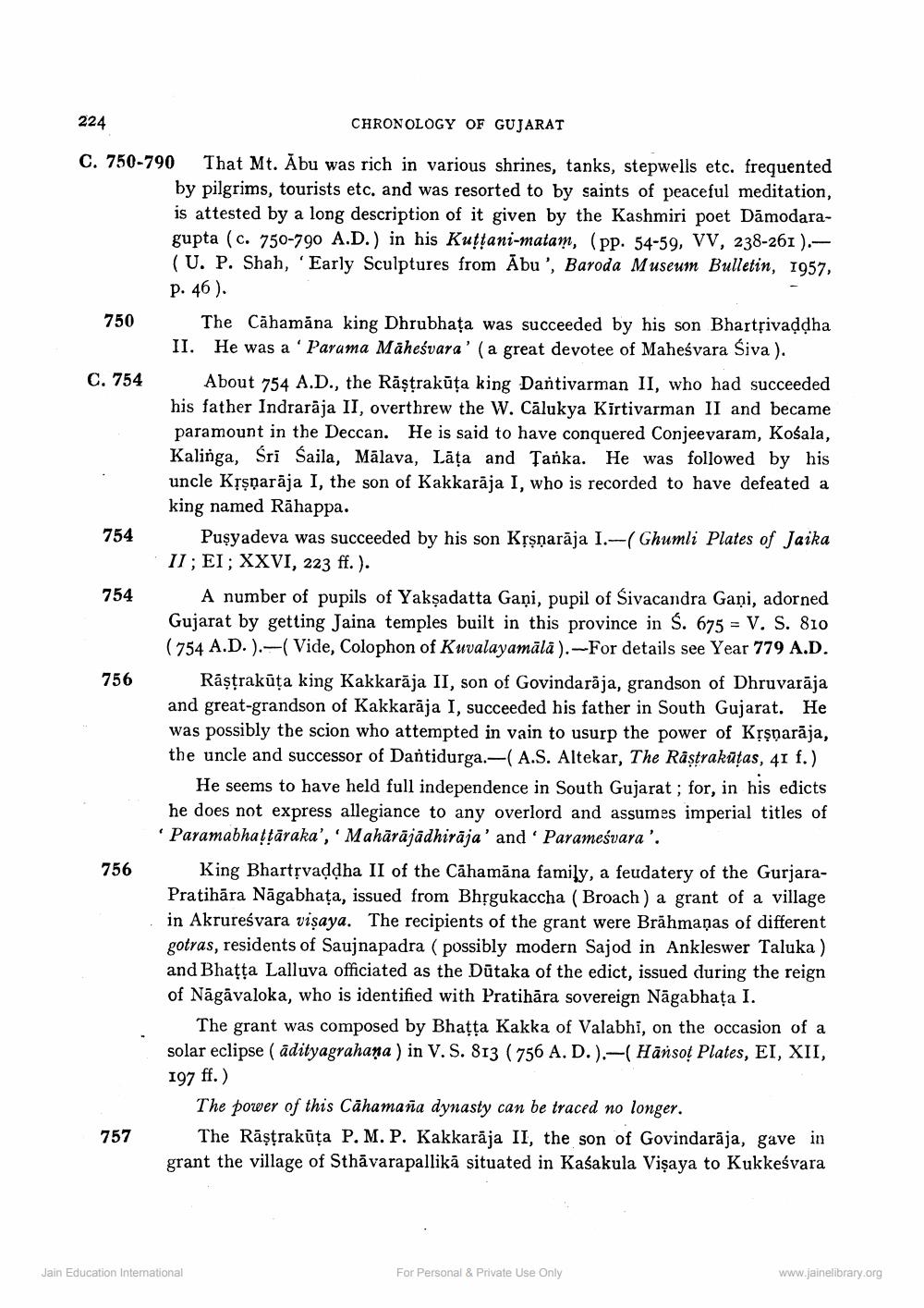________________
224
CHRONOLOGY OF GUJARAT
C. 750-790 That Mt. Abu was rich in various shrines, tanks, stepwells etc. frequented
by pilgrims, tourists etc. and was resorted to by saints of peaceful meditation, is attested by a long description of it given by the Kashmiri poet Damodaragupta (c. 750-790 A.D.) in his Kuțțani-matam, (pp. 54-59, VV, 238-261 ).( U. P. Shah, 'Early Sculptures from Ābu ', Baroda Museum Bulletin, 1957,
p. 46). 750 The Cähamana king Dhrubhata was succeeded by his son Bhartsivaddha
II. He was a 'Parama Mäheśvara' (a great devotee of Maheśvara Siva ). C. 754 About 754 A.D., the Rāştrakūta king Dantivarman II, who had succeeded
his father Indrarāja II, overthrew the W. Cālukya Kirtivarman II and became
paramount in the Deccan. He is said to have conquered Conjeevaram, Kośala, Kalinga, Sri Saila, Mālava, Lāța and Tanka. He was followed by his uncle Kļşņarāja I, the son of Kakkarāja I, who is recorded to have defeated a king named Rāhappa.
Puşyadeva was succeeded by his son Kșsnarāja I.-( Ghumli Plates of Jaika II; EI; XXVI, 223 ff.).
A number of pupils of Yakşadatta Gaņi, pupil of Sivacandra Gani, adorned Gujarat by getting Jaina temples built in this province in $. 675 = V. S. 810
( 754 A.D.).-(Vide, Colophon of Kuvalayamāla). -For details see Year 779 A.D. 756 Rāșțrakūța king Kakkarāja II, son of Govindaraja, grandson of Dhruvarāja
and great-grandson of Kakkarāja I, succeeded his father in South Gujarat. He was possibly the scion who attempted in vain to usurp the power of Krşparāja, the uncle and successor of Dantidurga.—(A.S. Altekar, The Râştrakūtas, 41 f.)
He seems to have held full independence in South Gujarat; for, in his edicts he does not express allegiance to any overlord and assumes imperial titles of
Paramabhattāraka', Mahārājādhirāja' and 'Parameśvara'. 756 King Bhartļvaddha II of the Cāhamāna family, a feudatery of the Gurjara
Pratihāra Nāgabhața, issued from Bhỉgukaccha (Broach) a grant of a village in Akrureśvara visaya. The recipients of the grant were Brāhmaṇas of different gotras, residents of Saujnapadra ( possibly modern Sajod in Ankleswer Taluka ) and Bhatta Lalluva officiated as the Dūtaka of the edict, issued during the reign of Nāgāvaloka, who is identified with Pratihāra sovereign Nāgabhata I.
The grant was composed by Bhatta Kakka of Valabhi, on the occasion of a solar eclipse ( adityagrahana ) in V. S. 813 ( 756 A. D.):-( Hänsoț Plates, EI, XII, 197 ff.)
The power of this Cāhamaña dynasty can be traced no longer.
The Rāştrakūta P. M. P. Kakkarāja II, the son of Govindarāja, gave in grant the village of Sthāvarapallikā situated in Kaśakula Vişaya to Kukkeśvara
757
Jain Education International
For Personal & Private Use Only
www.jainelibrary.org




